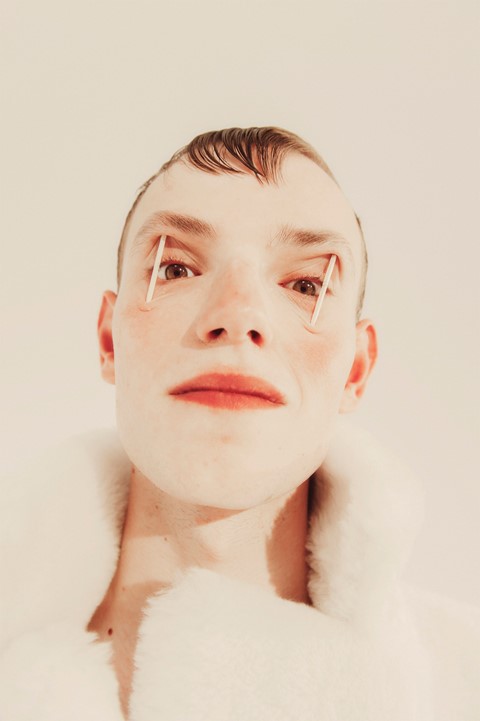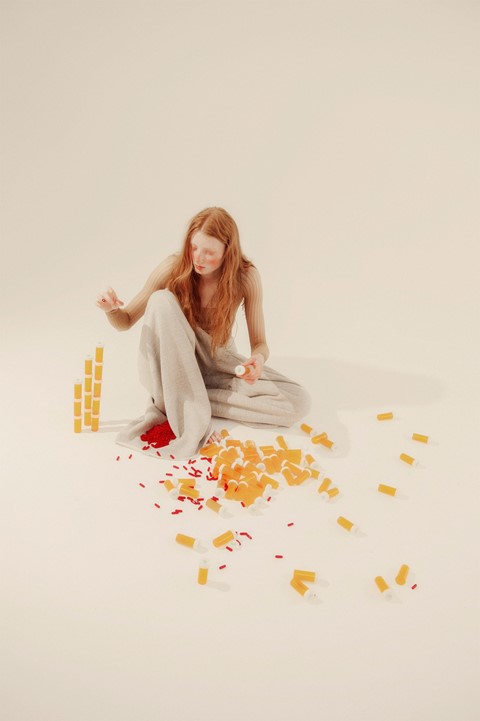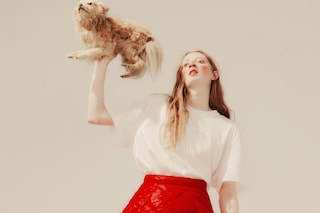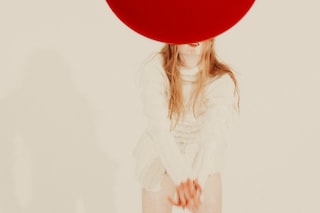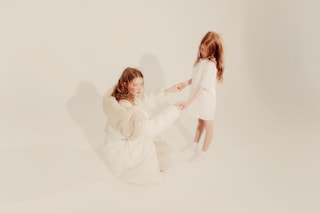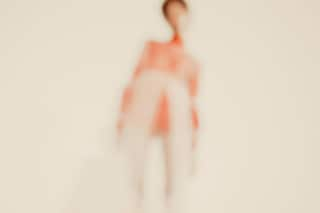Steph Wilson visualises various symptoms of and coping mechanisms for anxiety in her most personal shoot to date
Mental health is an invisible condition that presents itself in a unique way, depending on the person facing it. So how can it be communicated visually? In a new Dazed photo series called “The Bell Curve”, photographer Steph Wilson takes a personal approach to the depiction of anxiety. “My anxiety began at the age of 11, and lasted, unwavering, until about 22,” she reveals. This shoot serves as both a memorial of that time and an effort to visually explain anxiety to non-sufferers. Although mostly a portrait of her own experience, she also gathered the experiences of others with anxiety through social media. “Any mental health issue is, to a viewer, an invisible affliction due to the impossible dilemma of not being able to ‘see’ it,” she says. “It’s all thought, habit and emotion. It’s not tangible, and perhaps that is what makes it one of the most difficult things to treat and understand.” To make it tangible, she alternates between literal and symbolic interpretations of symptoms and coping mechanisms: showing little half-moons on the skin of a friend who clutches her arms in anxiety in one photo, shrouding a model in bodies to represent omnipresent claustrophobia in the next.
Below, we speak to the photographer about living with anxiety, visualising mental health issues, and why anxiety is never glamourised.
“You fall in love with your anxiety as much as you learn to despise it” – Steph Wilson
Tell us about your series ‘The Bell Curve’, especially your intent and what you wanted to portray?
Steph Wilson: ‘The Bell Curve’ memorialises an anxiety-ridden, ten-year period of my life, aptly with the thing that helped to cure it – my photography. The title itself is from a particular moment of my CBT (Cognitive Behavioral Therapy) sessions. Severe anxiety and panic attacks were described to me as a bell curve: there is a peak, and after that peak, it eventually drops. When suffering a panic attack you are convinced of its (lasting for) eternity, however understanding that it can’t last forever often greatly reduces its duration.
I wanted to distil all the symptoms of my anxiety disorder into this shoot, perhaps as a form of catharsis and, at last, to use it to create something of positive affect. I asked around on social media to gauge other people’s history of anxiety, and the response was pretty staggering. It made me want to portray their experiences along with my own, including those of Hazel (one of the models in the shoot), who suffers from social anxiety. Another vital choice was to cast a male model. It’s important to remind ourselves that, in the midst of this wave of feminism, men are also victims of anxiety, and the stigma of being a non-macho male can be very damaging.
Are there any specific instances or experiences in your life that inspired you, or that you drew from?
Steph Wilson: Anxiety, albeit a mental affliction and therefore ‘invisible’, is a very physical thing, or at least, its symptoms are. To cope, you find tactics that are a short-term solution to feeling like total shit. Once struck by blinding panic and nausea, you create your own personal antidote (some exacerbating the problem such as self-harm or, in my case, not eating – the logic being that eating led to throwing up in public.) I found the array of these personal ‘antidotes’ fascinating and quite beautiful in their creativity, along with the language used when explained. There was such affection in my friend Alice’s tone when describing the half moons created by digging her fingernails into the skin as a form of distraction. It really made me realise that you fall in love with your anxiety as much as you learn to despise it. So it was more a general fascination with the effect of anxiety on an individual that inspired me, rather than one instance in my life.
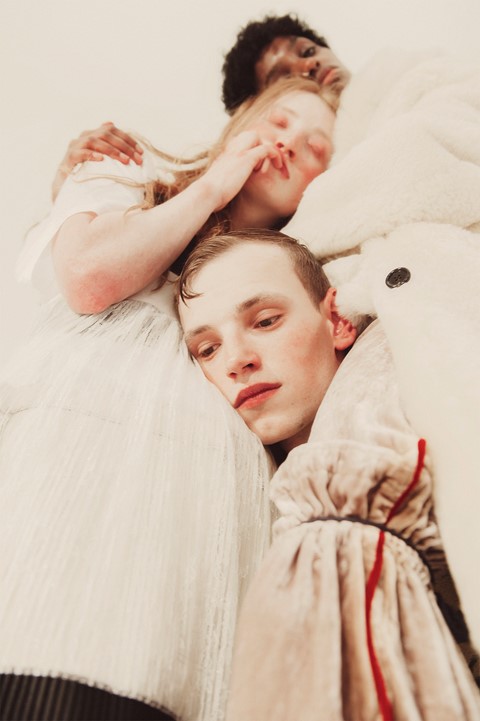
What is it about anxiety that you think makes it so apt for portrayal in a visual language like photography?
Steph Wilson: By physically portraying these symptoms and coping mechanisms it not only makes them recognisable to the sufferer but to those that may not have been able to comprehend them as a non-visual concept. As mental health is such an internal affliction, those that don’t suffer it may find it hard to understand. In short, I hoped to make the invisible visible through the medium of photography, (and) that a physical portrayal would help to open up a more relatable dialogue on the subject.
The series’ aesthetic is very stark but also peaceful in a way – which is very ironic, given the subject matter. What was your thought process in styling the shoot like this?
Steph Wilson: I wanted the shoot to focus on the subject and the symbolic props without too much distraction. There are also some personal comparisons I can draw from the peaceful mood of the shoot, such as when, in a potentially stressful scenario, I’ve taught myself to ‘zone out’. I go into a daydream-like trance and enjoy the dislocation from my surroundings. Often I find it a little amusing how calm I am amid such unnecessary stress. On an opposite note, the starkness could relate to feeling quite isolated at times, or the feeling that all focus is on you when feeling anxious. The styling, beautifully pulled off by Tereza (Ortiz), also played a big part in the shoot’s aesthetic. We talked about it representing comfort (duvets and pyjamas) along with claustrophobia in layering and heavy textures.
The current ‘sad girl’ aesthetic/trend is also an artistic representation of depression (especially female depression). What do you think about this trend and how do you think your series relates to and/or rejects that approach?
Steph Wilson: I hadn’t thought about it before the shoot at all, and I certainly didn’t intend to create a link to the sad girl aesthetic (nor reject it), although I think it’s an interesting link to make. I wouldn’t opt to create work that romanticises mental health issues in that way, personally – to create yet another ‘damsel in distress’. To me, my anxiety dictated almost half of my life and, to be honest, it can fuck right off. What I’m saying is, this shoot isn’t paying homage to my anxiety, but attempting to distil it in a series of images. I feel that the sad girl trend is ornamenting the notion of being sad – maybe because the cinematic potential of teenage girls in their pastel adorned bedrooms with a gem-drop tear is so high: a modern-day Ophelia lying, motionless, in their en-suite bathtubs. Anxiety, however, is ugly and prickly and hollow. It doesn’t deserve a fashion trend.
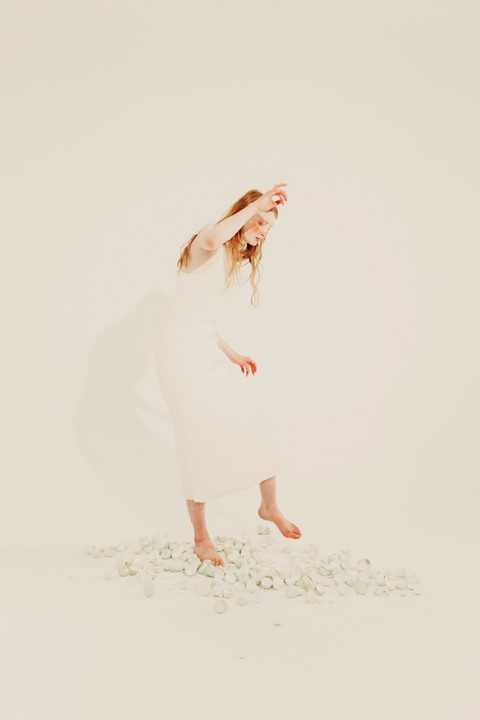
Why do you think anxiety has not been romanticised or even sexualised (in some instances) as much as depression?
Steph Wilson: Anxiety is like depression’s whiney younger sibling. People will listen intently about the ‘black abyss of your empty soul’, but when it’s hearing about how difficult sharing a cab to the station with your mate’s mum is, it doesn’t have the same ring. We’ve finally come to terms with the fact that depression is a serious illness and we respect that. Even so, anxiety is often a by-product of depression (or vice versa), yet it seems a lot more common for anxiety to initiate a ‘suck it up’ attitude in non-anxious people. Depression is also, if imagined as a “thing’, much more sultry. We mope and we sleep, cry and bleed and blankly stare out of windows when depressed; imagery that can be made poetic and sexy. Anxiety, however, is shivery and quick and we scuttle about like little broken birds seeking safety in the nearest toilet. Scuttling, shifty things can never be made sexy.
If you had to choose one overarching image to represent your anxiety at its worst, what would it be?
Steph Wilson: My anxiety at its worst was the nausea aspect of it. We – Tereza and I – felt that expressing my relationship with food and nausea would be sensitive when portrayed with a model, as it would infringe on other topics such as anorexia in the fashion industry which, obviously, has nothing to do with the shoot. This caused me to leave it out more than I would have liked, as it was such a big part of everything.
When I was 11 years old I remember lying in bed and telling my mother I wanted to die. I’d clutch at the bed sheets – this tiny, skinny twiglet of a thing – sweating and squirming around in bed, drenched in nausea. I guess it’d be an image of that. In the foreground would be the milkshake my father forced me to drink before school (in an attempt to calm my stomach), which ended up in vomit-form at the feet of the hot blonde girls a few grades above. It was fucking dreadful, but now I think about it, fucking hilarious. I think one of the girls ended up on Made in Chelsea for a brief period.
